Photography, a transformative medium, has revolutionized how we perceive history and the world around us since its inception in the early 19th century. From capturing fleeting moments to documenting groundbreaking events, photography’s journey is a testament to human innovation and our desire to preserve and share our experiences. To truly appreciate its impact, let’s explore a curated collection of photographic “firsts,” answering the core question: When Was The First Photo Taken and how did this evolve into the diverse world of photography we know today? These pioneering images represent not only the earliest captures of their subjects but also the dawn of new possibilities within this ever-evolving art and science.
1. The Very First Photograph: A Rooftop View in France
The question “when was the first photo taken?” leads us directly to 1826. This year marks the creation of “View from the Window at Le Gras,” widely recognized as the world’s first photograph. Joseph Nicéphore Niépce, a French inventor, achieved this groundbreaking feat from his estate in the Burgundy region of France. Utilizing a process he termed heliography – “sun drawing” – Niépce coated a pewter plate with Bitumen of Judea, a light-sensitive asphalt. This plate was then placed inside a camera obscura, and after an unprecedented eight-hour exposure, the faint, yet indelible, image of his courtyard rooftops emerged. This pioneering image, though rudimentary by today’s standards, marked the momentous answer to “when was the first photo taken?” in a camera, forever changing visual representation.
2. The First Color Photograph: A Ribbon of Color
While the first photograph was monochromatic, the quest for capturing color quickly followed. The first durable color photograph materialized in 1861, thanks to the scientific ingenuity of James Clerk Maxwell, a mathematical physicist. This image, often referred to as the “tartan ribbon” photograph, showcased a colored ribbon. Maxwell, understanding the principles of color vision, devised a three-filter method. Photographs were taken through red, green, and blue filters separately by Thomas Sutton, the inventor of the SLR camera. These were then combined to project a color image, demonstrating the early potential of color photography, a significant step beyond the initial black and white images.
3. The First Person Born Ever Photographed: Hannah Stilley Gorby
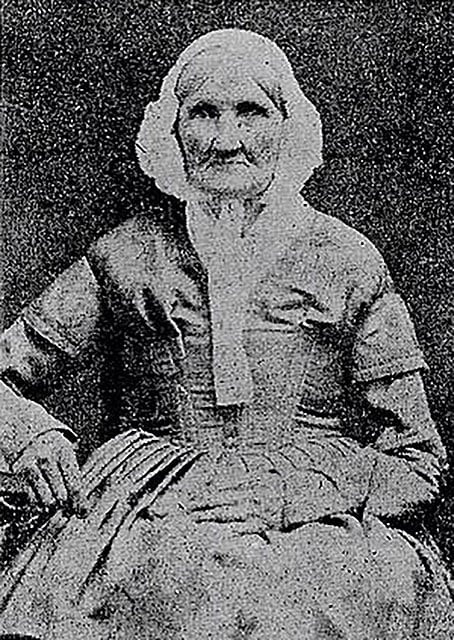
Delving into the history of portraiture, we encounter Hannah Stilley Gorby. Born in 1746, Gorby holds the distinction of being the earliest-born individual ever captured in a surviving photograph. Her life spanned a remarkable period, predating even Mozart and Napoleon. While these historical figures lived before photography’s invention, Gorby, at the age of 94, embraced the new technology, posing for a portrait in 1840. This photograph provides a tangible link to the 18th century, bridging generations through the nascent art of photography.
4. The First Digital Photograph: A Glimpse of the Digital Age
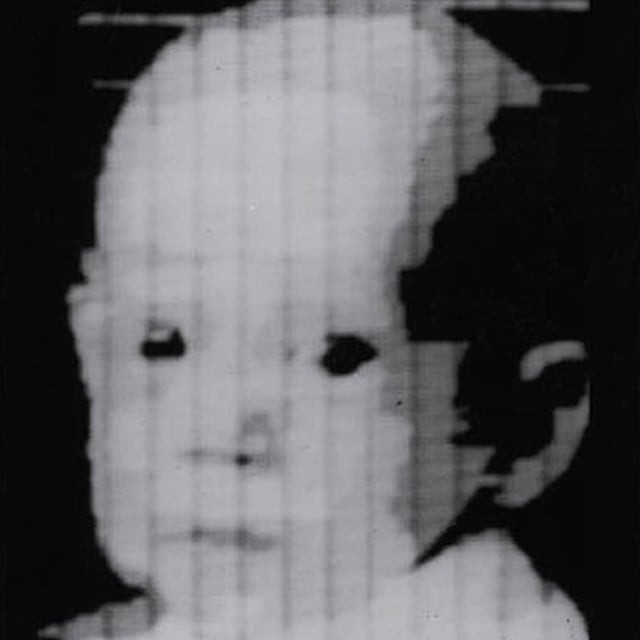 The first digital photo ever made, showing a baby. Alt text: First digital photograph, 1957, Russell Kirsch, baby son, early digital imaging.
The first digital photo ever made, showing a baby. Alt text: First digital photograph, 1957, Russell Kirsch, baby son, early digital imaging.
The digital revolution in photography began surprisingly early. In 1957, decades before digital cameras became commonplace, the first digital photograph was created. This image, a digital scan of a film photograph, depicted Russell Kirsch’s infant son. With a modest resolution of 176×176 pixels, this square image, captured long before Instagram, marked the pioneering steps towards the digital photography era. It foreshadowed the shift from chemical processes to electronic image capture, fundamentally changing the future of photography.
5. The First Photograph of a Person: A Parisian Street Scene
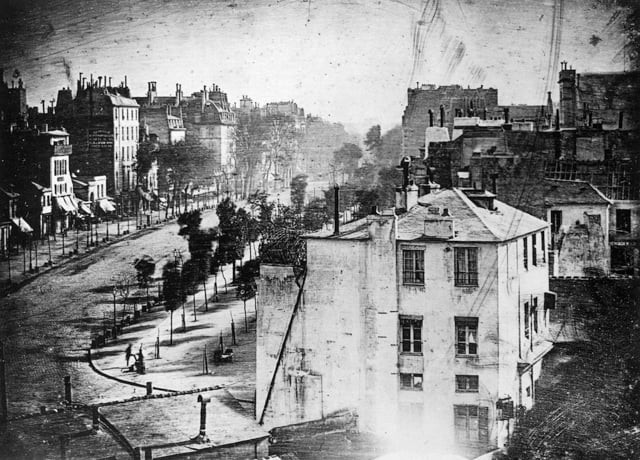 A black-and-white street scene from a high vantage point, showing a person in the lower left corner. Alt text: First photograph of a person, 1838, Louis Daguerre, Boulevard du Temple, Paris, early street photography.
A black-and-white street scene from a high vantage point, showing a person in the lower left corner. Alt text: First photograph of a person, 1838, Louis Daguerre, Boulevard du Temple, Paris, early street photography.
Louis Daguerre, another pivotal figure in early photography, captured what is considered the first photograph featuring a human in 1838. His daguerreotype of the Boulevard du Temple in Paris, required a lengthy seven-minute exposure. Due to the extended exposure, moving subjects blurred into invisibility. However, in the lower-left corner, a man standing still to have his shoes shined remained sharply in focus, inadvertently becoming the first person knowingly (or unknowingly) photographed. This image, initially intended as a cityscape, inadvertently documented a fleeting moment of everyday life, making it a remarkable historical capture.
6. The First Portrait Photograph: A Self-Portrait Milestone
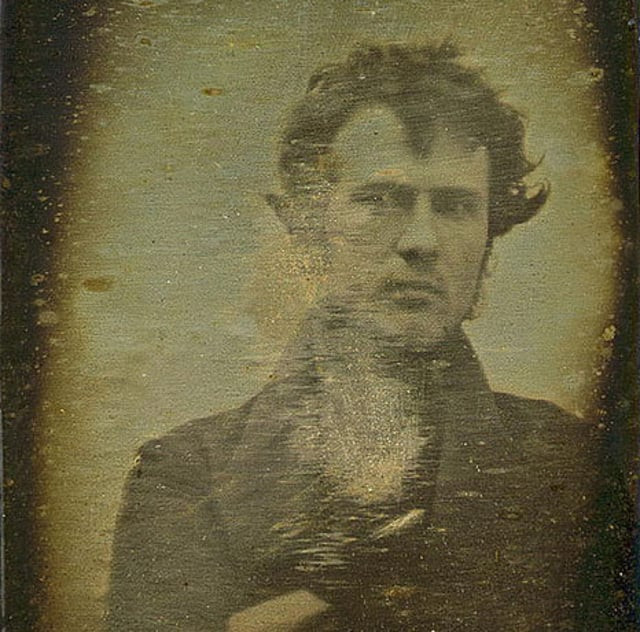 A self-portrait of Robert Cornelius, a man looking directly at the camera. Alt text: First portrait photograph, 1839, Robert Cornelius self-portrait, early American photography.
A self-portrait of Robert Cornelius, a man looking directly at the camera. Alt text: First portrait photograph, 1839, Robert Cornelius self-portrait, early American photography.
Before the age of selfies, Robert Cornelius, an American pioneer in photography, created the world’s first portrait photograph, which was also a self-portrait. In 1839, behind his Philadelphia business, Cornelius positioned a camera, removed the lens cap, sat for just over a minute, and then replaced the cap. This iconic image, taken over 170 years ago, represents the dawn of portrait photography and the human desire for self-representation through this new medium.
7. The First Hoax Photograph: A Staged Suicide Scene
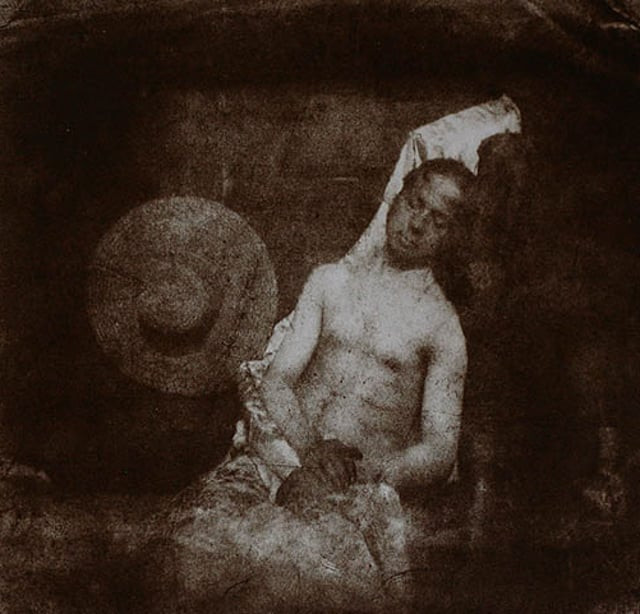 A photo that appears to show a deceased man lying by a riverbank. Alt text: First hoax photograph, 1840, Hippolyte Bayard, self-portrait as a drowned man, early photographic manipulation.
A photo that appears to show a deceased man lying by a riverbank. Alt text: First hoax photograph, 1840, Hippolyte Bayard, self-portrait as a drowned man, early photographic manipulation.
The history of photography isn’t without its controversies. Hippolyte Bayard, an early photography innovator, staged the first hoax photograph in 1840. Feeling overlooked in the recognition of photography’s invention, Bayard created a self-portrait depicting himself as a drowned man. He included a text lamenting his supposed suicide due to the lack of recognition for his photographic process, which he claimed predated Daguerre’s. This image serves as an early example of photographic manipulation and the use of the medium for social commentary and protest.
8. The First Aerial Photograph: Boston from Above
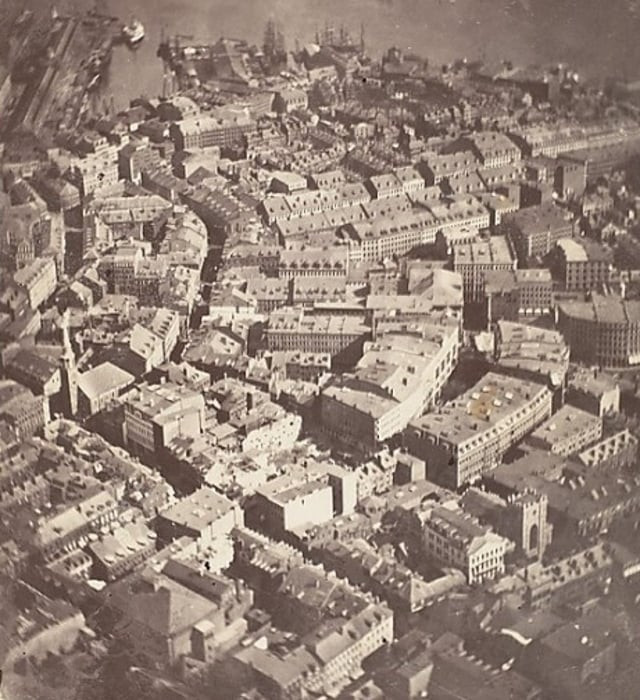 An aerial photo showing the rooftops of Boston in 1860. Alt text: First aerial photograph, 1860, James Wallace Black, Boston from hot air balloon, early aerial perspective.
An aerial photo showing the rooftops of Boston in 1860. Alt text: First aerial photograph, 1860, James Wallace Black, Boston from hot air balloon, early aerial perspective.
The perspective photography offered expanded literally skyward in 1860. James Wallace Black captured the first aerial photograph, not from a drone, but from a hot air balloon. Soaring 2,000 feet above Boston, Black’s photograph, titled “Boston, as the Eagle and the Wild Goose See It,” provided a breathtaking bird’s-eye view of the city. This image demonstrated the unique vantage point photography could offer, opening up new applications in surveying, urban planning, and artistic expression.
9. The First Photograph of the Sun: Capturing Our Star
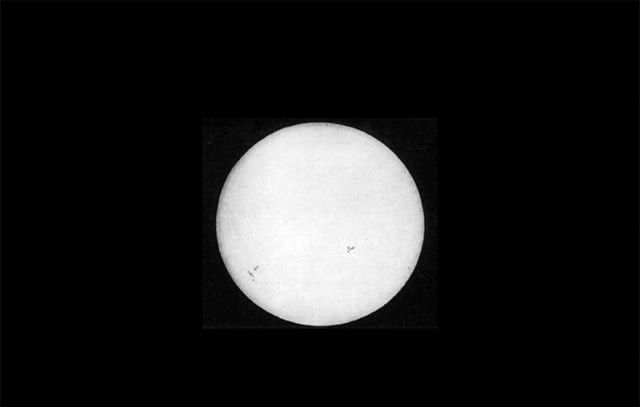 The earliest known photo of the Sun, showing sunspots. Alt text: First sun photograph, 1845, Louis Fizeau and Leon Foucault, daguerreotype of the sun, early solar photography.
The earliest known photo of the Sun, showing sunspots. Alt text: First sun photograph, 1845, Louis Fizeau and Leon Foucault, daguerreotype of the sun, early solar photography.
Venturing beyond earthly subjects, French physicists Louis Fizeau and Leon Foucault successfully photographed the sun in 1845. Using the daguerreotype process and a mere 1/60th of a second exposure, they captured an image revealing sunspots for the first time photographically. This pioneering solar photograph opened avenues for astronomical observation and the study of celestial bodies through the nascent technology of photography.
10. The First Space Photograph: Earth from the Heavens
 A black and white photo captured by a V-2 rocket, showing Earth from space. Alt text: First space photograph, 1946, V-2 rocket, Earth from 65 miles altitude, early space exploration photography.
A black and white photo captured by a V-2 rocket, showing Earth from space. Alt text: First space photograph, 1946, V-2 rocket, Earth from 65 miles altitude, early space exploration photography.
The reach of photography extended into space in 1946. Launched on a V-2 #13 rocket, a 35mm motion picture camera captured the first photograph of Earth from space. Taken at an altitude of 65 miles, this black-and-white image offered a groundbreaking perspective of our planet, initiating the era of space photography and providing humanity with its first photographic glimpse of Earth from beyond.
11. The First News Photograph: Documenting Arrest in France
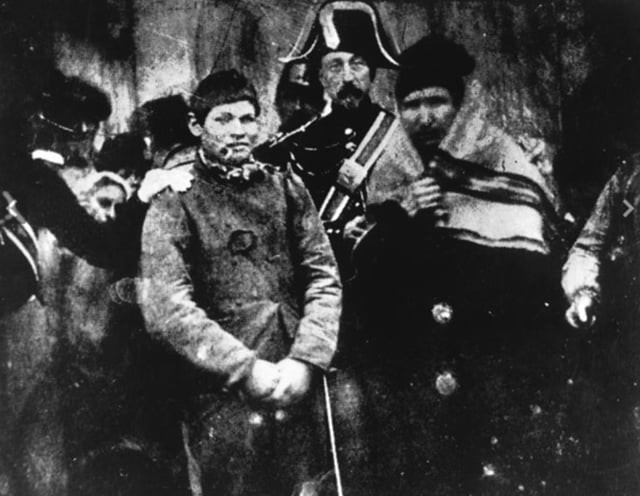 An old photo showing a man being arrested by officers in France. Alt text: First news photograph, 1847, unknown photographer, arrest in France, early photojournalism.
An old photo showing a man being arrested by officers in France. Alt text: First news photograph, 1847, unknown photographer, arrest in France, early photojournalism.
Photography’s role in journalism emerged early on. In 1847, an unnamed photojournalist captured what is believed to be the first news photograph – an image of a man being arrested in France. Taken using the daguerreotype process, this photograph demonstrated photography’s potential to document current events, paving the way for photojournalism and its crucial role in informing the public.
12. The First Newspaper Photo: Barricades in Paris
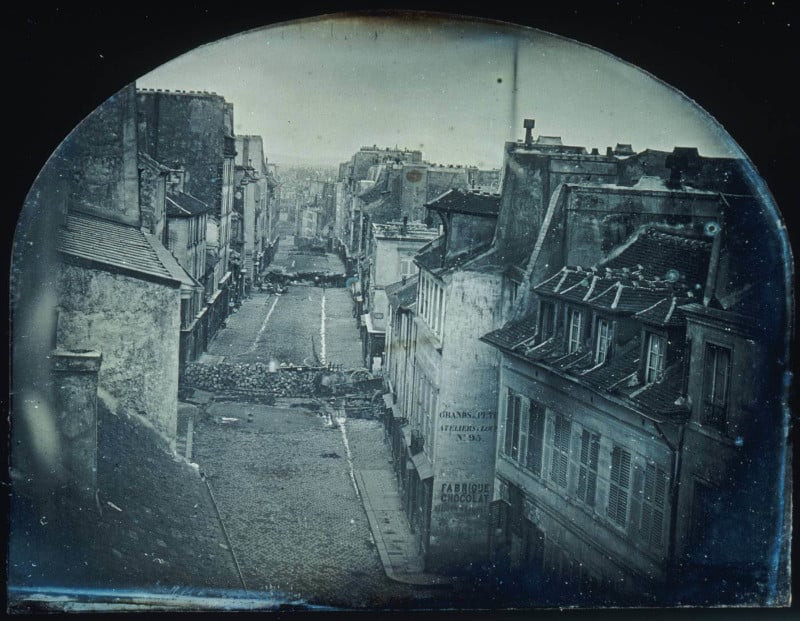
The integration of photography into newspapers soon followed. On June 25, 1848, a daguerreotype titled “Barricades on rue Saint-Maur” captured the scene of Parisian barricades during the June Days uprisings. This image, reproduced as an engraving, was published in the French weekly newspaper L’Illustration in July 1848, marking the first instance of a photograph illustrating a news story in a newspaper, solidifying photography’s place in visual reporting.
13. The First President Photograph: John Quincy Adams
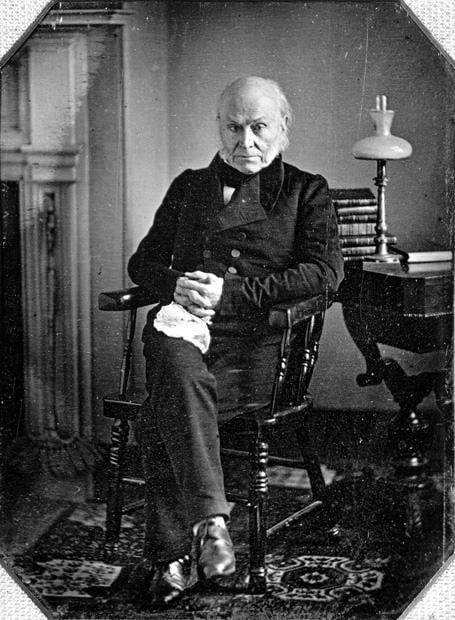 A portrait of US President John Quincy Adams. Alt text: First presidential photograph, 1843, John Quincy Adams, daguerreotype portrait, early presidential image.
A portrait of US President John Quincy Adams. Alt text: First presidential photograph, 1843, John Quincy Adams, daguerreotype portrait, early presidential image.
US President John Quincy Adams, the sixth president, holds the distinction of being the first president photographed. His daguerreotype portrait was taken in 1843, years after his presidency concluded in 1829. While Adams was the first president photographed overall, James Polk, the 11th president, was the first to be photographed while in office in 1849. These early presidential photographs marked the beginning of a tradition of visually documenting American leadership.
14. The First Lightning Photograph: Unveiling Nature’s Power
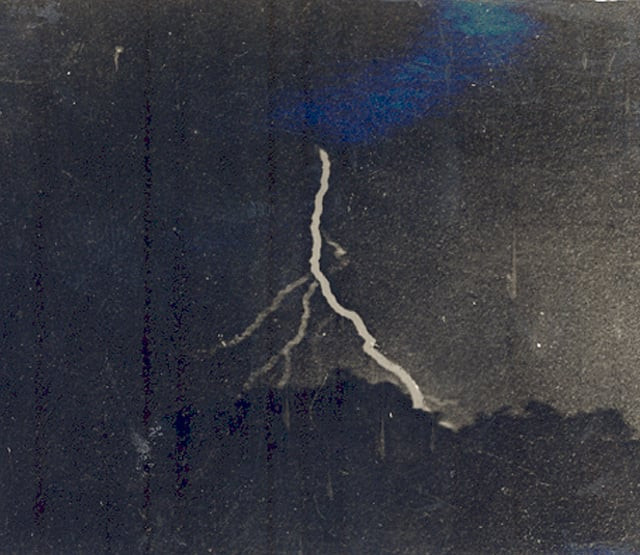 The earliest known photograph of lightning, showing its branching structure. Alt text: First lightning photograph, 1882, William Jennings, branched lightning, early atmospheric photography.
The earliest known photograph of lightning, showing its branching structure. Alt text: First lightning photograph, 1882, William Jennings, branched lightning, early atmospheric photography.
Capturing fleeting natural phenomena became another photographic pursuit. In 1882, William Jennings succeeded in taking the first photograph of lightning. His image revealed the complex, branching structure of lightning, challenging previous understandings and demonstrating photography’s ability to scientifically document natural events with unprecedented detail.
15. The First Fatal Airplane Crash Photograph: A Somber Record
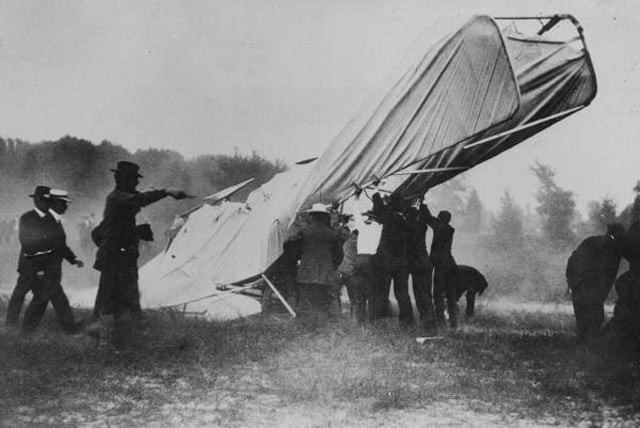 A black and white photograph of the wreckage of a fatal plane crash in 1908. Alt text: First fatal airplane crash photograph, 1908, Thomas Selfridge crash, early aviation disaster photography.
A black and white photograph of the wreckage of a fatal plane crash in 1908. Alt text: First fatal airplane crash photograph, 1908, Thomas Selfridge crash, early aviation disaster photography.
Photography also began to document tragic events. This 1908 photograph captured the aftermath of a fatal airplane crash that claimed the life of aviator Thomas Selfridge. Orville Wright, also on board, survived. This somber image serves as an early example of disaster photography, highlighting the medium’s role in recording and learning from tragic events in the burgeoning age of aviation.
16. The First Moon Photograph: Our Celestial Neighbor
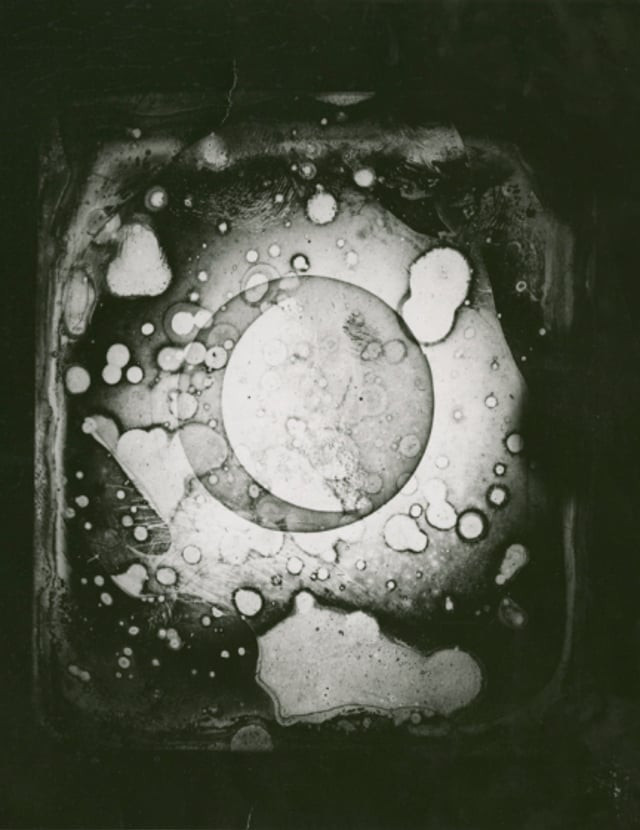 An old daguerreotype of the moon, showing surface details. Alt text: First moon photograph, 1840, John W. Draper, daguerreotype of the moon, early lunar photography.
An old daguerreotype of the moon, showing surface details. Alt text: First moon photograph, 1840, John W. Draper, daguerreotype of the moon, early lunar photography.
John W. Draper achieved another astronomical first in 1840 by taking the first photograph of the moon. From his rooftop observatory at New York University, Draper captured a daguerreotype of our celestial neighbor. Though damaged over time, this image marked the beginning of lunar photography and further extended photography’s reach beyond Earth.
17. The First Colored Landscape Photograph: Southern France in Hue
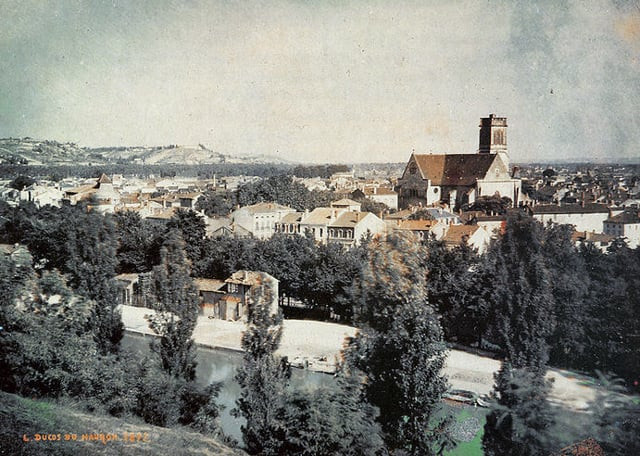 A slightly colorful landscape photo of a town in Southern France. Alt text: First color landscape photograph, 1877, Louis Arthur Ducos du Hauron, Southern France landscape, early color landscape photography.
A slightly colorful landscape photo of a town in Southern France. Alt text: First color landscape photograph, 1877, Louis Arthur Ducos du Hauron, Southern France landscape, early color landscape photography.
Louis Arthur Ducos du Hauron, a pioneer in color photography, created the first colored landscape photograph in 1877. His photograph, titled “Landscape of Southern France,” showcased the world in color, capturing the hues of the French countryside. This image demonstrated the advancements in color photography and its potential to capture the vibrancy of natural landscapes.
18. The First Photograph of Earth from the Moon: Earthrise
While no image is provided in the original article, the text mentions: The Earth was photographed from the Moon on August 23rd, 1966, by a Lunar Orbiter spacecraft. This momentous image, received in Spain, captured Earth rising above the lunar horizon, providing a powerful and iconic perspective of our planet from another celestial body. This event, though text-based in the original, is a crucial milestone in space photography and our understanding of our place in the cosmos.
19. The First Tornado Photograph: Nature’s Fury Documented
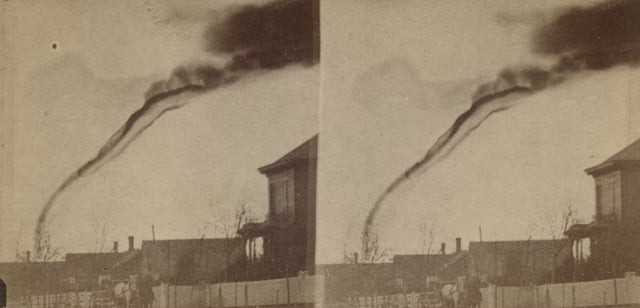 The earliest known photos of a tornado, showing a funnel cloud in a landscape. Alt text: First tornado photograph, 1884, A.A. Adams, tornado in Kansas, early storm photography.
The earliest known photos of a tornado, showing a funnel cloud in a landscape. Alt text: First tornado photograph, 1884, A.A. Adams, tornado in Kansas, early storm photography.
Documenting extreme weather became another early photographic endeavor. In 1884, amateur photographer A.A. Adams, a fruit farmer in Anderson County, Kansas, captured the first tornado photograph. Using his box camera, Adams photographed the cyclone from 14 miles away, providing the earliest visual record of these powerful and destructive natural phenomena.
20. The First Photograph from Mars: Red Planet Revealed
While no image is provided in the original article, the text mentions: The first image of Mars was taken by Viking 1 on July 20th, 1976, shortly after landing. This photograph, transmitted back to Earth, provided humanity’s first ground-level view of the Martian surface, revolutionizing our understanding of the red planet’s landscape and geology. This event, though text-based in the original, is a landmark achievement in space exploration and planetary photography.
21. The First 3D American President Portrait Photograph: Obama in Three Dimensions
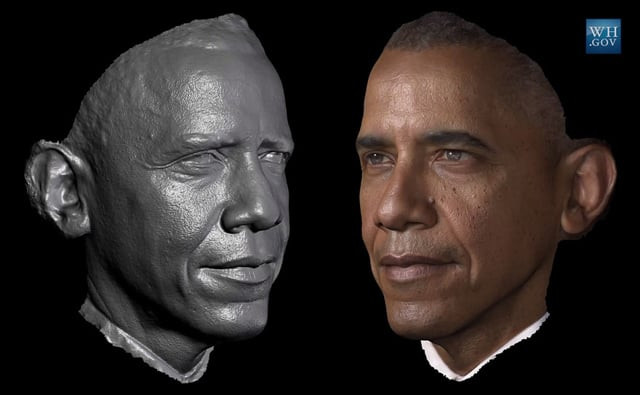 A 3-dimensional portrait of US President Barack Obama. Alt text: First 3D presidential portrait, Barack Obama, Smithsonian and USC ICT collaboration, modern 3D imaging.
A 3-dimensional portrait of US President Barack Obama. Alt text: First 3D presidential portrait, Barack Obama, Smithsonian and USC ICT collaboration, modern 3D imaging.
Technological advancements continued to shape photography. In a collaboration between the Smithsonian and the USC Institute for Creative Technologies, the first 3D Presidential Portrait was created of Barack Obama. Utilizing a complex array of cameras and LED lights, this portrait was then 3D printed, representing a fusion of photography and advanced digital technologies to create a new form of portraiture.
22. The First Photograph of a Black Hole: Unveiling the Invisible
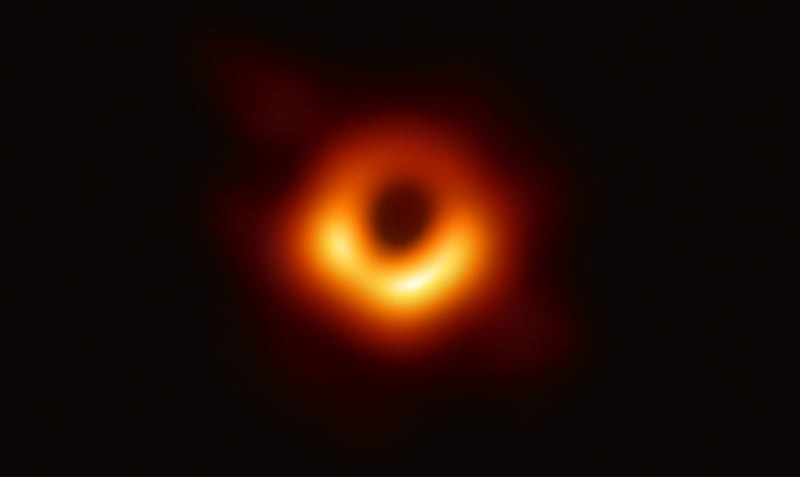 The first ever photograph of a black hole, showing a ring of light around darkness. Alt text: First black hole photograph, 2019, Event Horizon Telescope collaboration, Messier 87 black hole, groundbreaking astrophysics image.
The first ever photograph of a black hole, showing a ring of light around darkness. Alt text: First black hole photograph, 2019, Event Horizon Telescope collaboration, Messier 87 black hole, groundbreaking astrophysics image.
In a monumental scientific achievement, the first photograph of a black hole was unveiled in April 2019. The result of years of collaboration by over 200 astronomers worldwide, this image of the supermassive black hole at the center of galaxy Messier 87 was captured using a network of telescopes across the globe. Petabytes of data were processed by supercomputers to produce this groundbreaking image, confirming Einstein’s theories and providing visual evidence of these enigmatic cosmic entities.
23. The First Photo of the Far Side of the Moon: Dark Side Revealed
 A photo of the far side of the moon, showing its cratered surface. Alt text: First far side of the moon photograph, 2019, China's Chang'e-4 probe, lunar far side exploration, historic space image.
A photo of the far side of the moon, showing its cratered surface. Alt text: First far side of the moon photograph, 2019, China's Chang'e-4 probe, lunar far side exploration, historic space image.
China achieved a space exploration milestone in January 2019 by becoming the first country to soft-land a spacecraft on the far side of the Moon. The Chang’e-4 probe transmitted the first photograph ever captured of the “dark side of the Moon,” revealing its heavily cratered and distinct terrain, an area previously unseen by human eyes.
24. The First Photo of New York City: An Early Metropolis
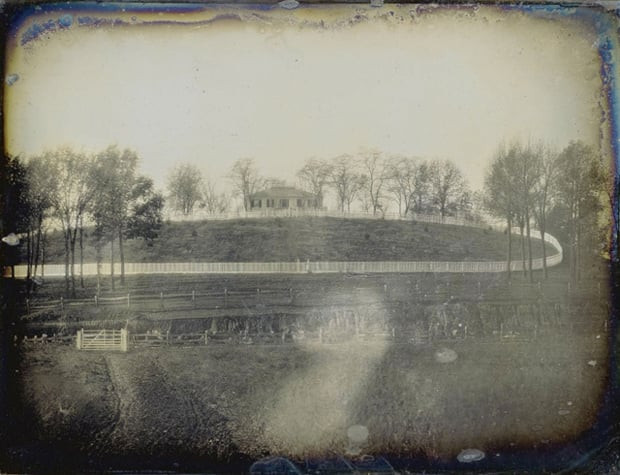 The oldest surviving photo of New York City, showing buildings and streets. Alt text: Oldest New York City photograph, 1848, daguerreotype, early urban photography, historic city view.
The oldest surviving photo of New York City, showing buildings and streets. Alt text: Oldest New York City photograph, 1848, daguerreotype, early urban photography, historic city view.
The oldest surviving photograph of New York City is a daguerreotype created in 1848. This image captures an early view of the burgeoning metropolis, offering a glimpse into the city’s 19th-century urban landscape. This historical photograph provides a valuable visual record of New York City’s early development.
25. The First Photo of Quantum Entanglement: Visualizing the Invisible
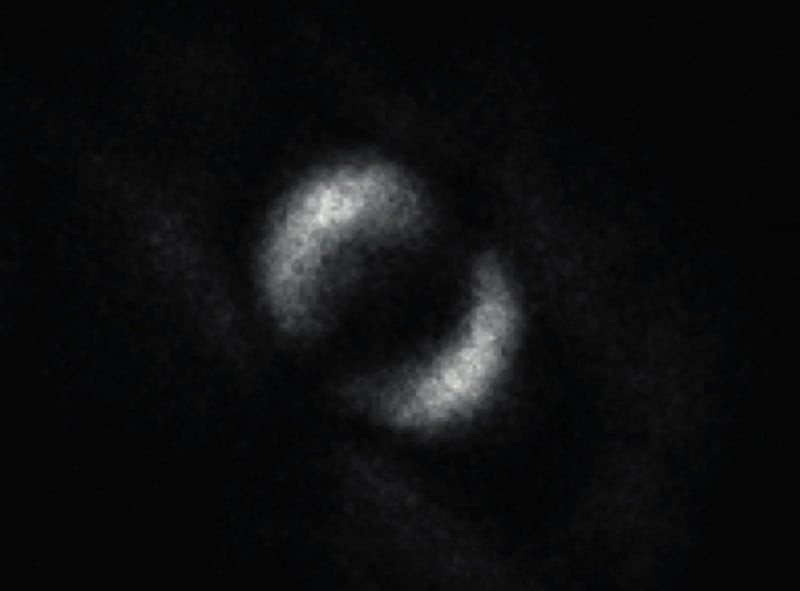 A black-and-white photo of quantum entanglement visualized as rings and patterns. Alt text: First quantum entanglement photograph, 2019, scientists visualize entanglement, quantum physics imaging.
A black-and-white photo of quantum entanglement visualized as rings and patterns. Alt text: First quantum entanglement photograph, 2019, scientists visualize entanglement, quantum physics imaging.
In 2019, scientists achieved a remarkable feat by capturing the first photograph of quantum entanglement. This image visualizes the phenomenon where two particles are linked regardless of distance. Created by firing a laser at a crystal, generating entangled photons, this photograph offers a visual representation of a complex and previously unseen aspect of quantum physics.
26. The First Camera Phone Photo: Birth of Mobile Photography
 The first camera phone photo by Philippe Kahn, showing his newborn daughter. Alt text: First camera phone photo, 1997, Philippe Kahn, daughter Sophie, birth of mobile photography.
The first camera phone photo by Philippe Kahn, showing his newborn daughter. Alt text: First camera phone photo, 1997, Philippe Kahn, daughter Sophie, birth of mobile photography.
The advent of mobile photography is marked by the first camera phone photo taken on June 11, 1997, by Philippe Kahn. Using a jury-rigged setup of a digital camera, cell phone, and laptop in a maternity ward, Kahn captured and instantly shared the first photos of his newborn daughter with thousands of people. This marked the birth of camera phone photography and the beginning of an era of ubiquitous image sharing.
27. The First Photo Shot Inside the Sun’s Corona: Into the Solar Atmosphere
 A photo captured by a NASA probe from within the Sun's corona, showing solar streamers. Alt text: First sun's corona photograph, 2018, NASA Parker Solar Probe, coronal streamers, extreme solar photography.
A photo captured by a NASA probe from within the Sun's corona, showing solar streamers. Alt text: First sun's corona photograph, 2018, NASA Parker Solar Probe, coronal streamers, extreme solar photography.
NASA’s Parker Solar Probe ventured closer to the sun than ever before, capturing the first photograph from within the Sun’s corona in November 2018. Taken from 16.9 million miles from the Sun’s surface, this image reveals coronal streamers, solar material ejected from our star, providing unprecedented insight into the sun’s atmosphere.
28. The First Cape Canaveral Launch Photograph: Witnessing Spaceflight History
 Photographers watching a rocket launch at Cape Canaveral in 1950. Alt text: First Cape Canaveral launch photograph, 1950, NASA photographers, Bumper 2 rocket, early space program documentation.
Photographers watching a rocket launch at Cape Canaveral in 1950. Alt text: First Cape Canaveral launch photograph, 1950, NASA photographers, Bumper 2 rocket, early space program documentation.
NASA photographers documented the first Cape Canaveral launch in July 1950. The photograph captures the launch of the ‘Bumper 2’ rocket, a two-stage rocket, and also shows other photographers documenting the event. This image is a historical record of early spaceflight and the beginning of Cape Canaveral’s role in space exploration.
29. The First Portrait of a Woman: Dorothy Catherine Draper
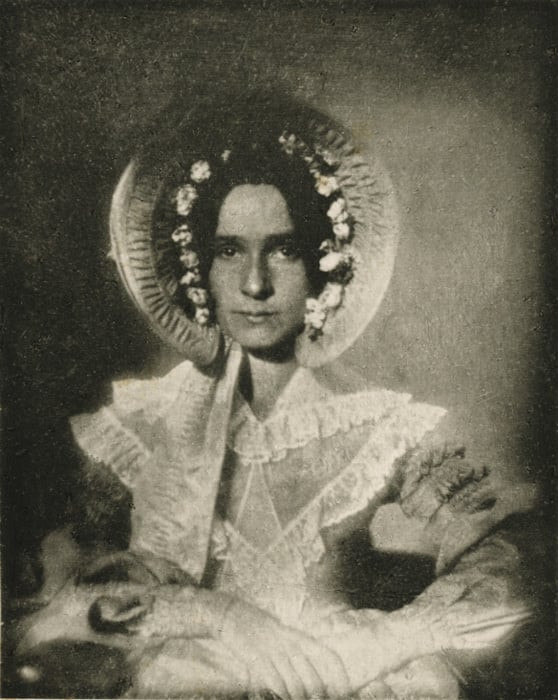
Dorothy Catherine Draper holds a significant place in photographic history as the subject of what is believed to be the first portrait photograph of a woman. Posing for her brother, Dr. John W. Draper, in his New York University studio around 1839 or 1840, this daguerreotype is also considered the first portrait made in the United States and the earliest surviving photograph of a woman, representing early portraiture and women’s representation in the new medium.
30. The First Photo of a Solar Eclipse: Documenting Celestial Alignment
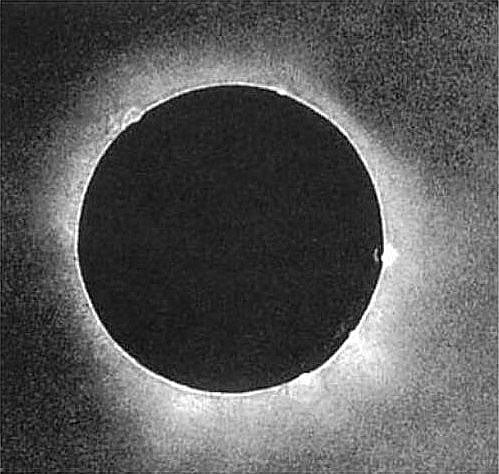
Johann Julius Berkowski, a relatively unknown photographer, captured the first properly exposed photograph of a solar eclipse on July 28, 1851. Using the daguerreotype process at the Royal Observatory in Königsberg, Prussia, Berkowski’s 84-second exposure captured the celestial alignment, demonstrating early astronomical photography and the documentation of rare astronomical events.
31. The First Photo of a Tornado (Duplicate Entry – see #19):
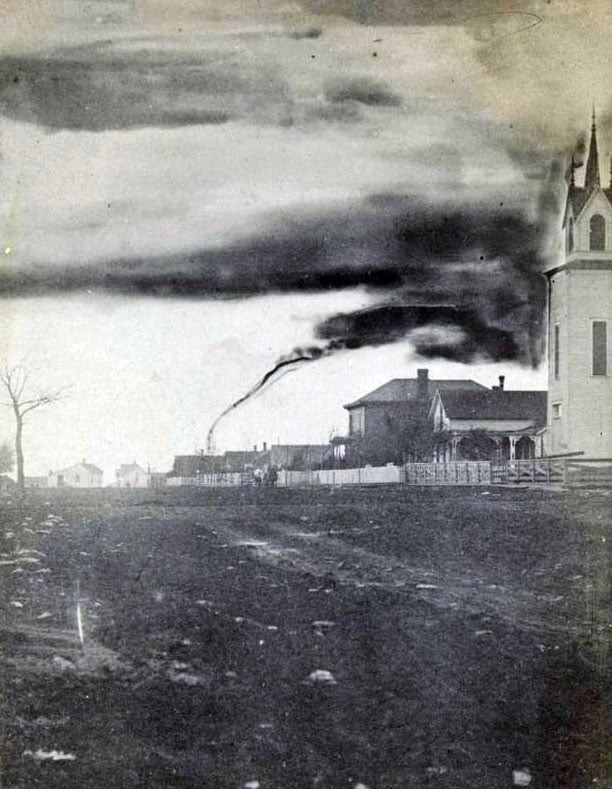
This entry is a duplicate of entry #19, reiterating the first tornado photograph captured by A.A. Adams in 1884 in Kansas. It reinforces the historical significance of this image as the earliest known photograph of a tornado, captured by an amateur photographer documenting a powerful natural phenomenon.
32. The First Photoshopped Photo: Jennifer in Paradise

The digital manipulation of photographs began with “Jennifer in Paradise.” Taken in Bora Bora in August 1988 by John Knoll, this vacation snapshot of his girlfriend Jennifer became the first image “Photoshopped.” Knoll, who later developed Photoshop, used this image to demonstrate the program’s capabilities. It became a standard sample image in early versions of Photoshop, marking the dawn of digital image editing and manipulation.
Conclusion:
The question, “when was the first photo taken?” opens a fascinating portal into the history of photography and human ingenuity. From Niépce’s rooftop view in 1826 to the digital manipulations of Photoshop, these photographic “firsts” illustrate a continuous journey of innovation and discovery. Each image represents a milestone, expanding the boundaries of what photography could capture – from the microscopic details of nature to the vast expanse of space, from fleeting moments in time to carefully constructed portraits. Photography’s evolution is a testament to our enduring curiosity and our relentless pursuit to visually document, understand, and share the world around us. These pioneering images not only answer “when was the first photo taken?” in various contexts, but also collectively narrate the incredible story of photography’s transformative impact on society and our perception of reality.
